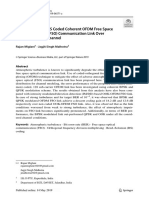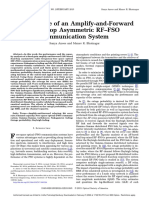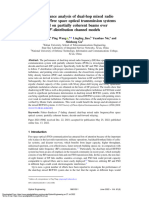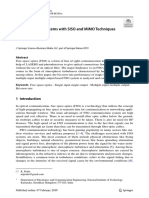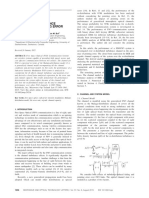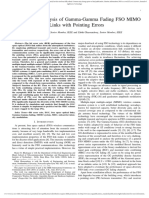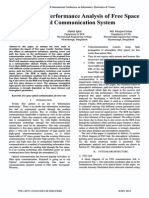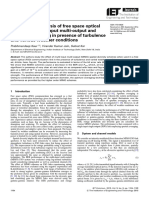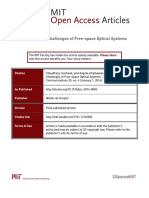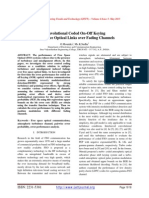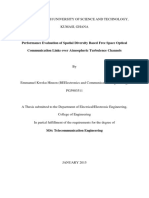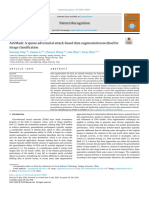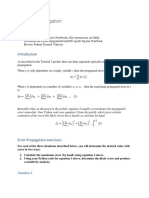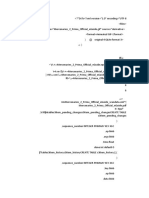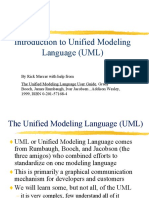Review of Error Analysis of FSO OFDM System
Uploaded by
Suman DasReview of Error Analysis of FSO OFDM System
Uploaded by
Suman DasProceedings of the 5th International Conference on Data Intelligence and Cognitive Informatics (ICDICI-2024)
IEEE Xplore Part Number: CFP24VL6-ART; ISBN: 979-8-3503-8960-9
Review of Error Analysis of FSO OFDM
System
2024 5th International Conference on Data Intelligence and Cognitive Informatics (ICDICI) | 979-8-3503-8960-9/24/$31.00 ©2024 IEEE | DOI: 10.1109/ICDICI62993.2024.10810906
Dr.M Selvi Dhanush P A Dinesh K
Department of Electronics and Department of Electronics and Department of Electronics and
Communication Engineering Communication Engineering Communication Engineering
Saveetha Engineering College Saveetha Engineering College Saveetha Engineering College
Chennai, India Chennai, India Chennai, India
selvim@saveetha.ac.in dhanushpa790@gmail.com dd155092@gmail.com
Abstract--- FSO communication provides range where installing cables is impractical, although its
without a license, greater bandwidth, and a safe effectiveness can be influenced by environmental
channel. Although PIN diodes are commonly employed variables such as fog or rain [1]. A digital
for identification, avalanche photodiodes are
modulation technique called orthogonal frequency
preferable in order to identify high-speed FSO signals
division multiplexing (OFDM) splits data into
in various functions. APD's dispersion of noise is input-
dependent Gaussian noise rather than input- several closely spaced, orthogonal subcarriers to
independent Gaussian noise. Companding methods ensure efficient transmission. This method improves
are commonly used to lower the peak-to-average- bandwidth efficiency and increases system
power ratio (PAPR) in OFDM systems. We examine resilience to interference and multipath fading,
analysis of error using on-off keying for different kinds making OFDM an important technology in modern
of detection. This research provides a machine learning communication systems such as Wi-Fi, 4G, 5G, and
and non- machine learning approach and evaluates its digital broadcasting. Orthogonal Frequency
execution against rigid and flexible judgments. We
Division Multiplexing with Free Space Optics
derive soft values for IDGN and IIGN and analyze
entails sending OFDM-modulated signals via the air
optimal and suboptimal detection thresholds. The
proposed unique ML technique outperforms the via laser beams. OFDM divides data into numerous
existing alternatives. subcarriers, enhancing efficiency and robustness,
whereas FSO enables high-speed wireless
Keywords— Error analysis, machine learning, optical transmission. [4] This combination provides
communication, PAPR, rigid and flexible decisions. efficient, high-capacity communication, which is
especially valuable in situations where traditional
I. INTRODUCTION
cabling is unfeasible. Combining these systems
Over the past few years, mobile phone applications enhances wireless communication by merging
have become increasingly popular, and the number OFDM's efficient data modulation and robustness
of applicants worldwide has been steadily rising against interference with FSO's high-speed, cable-
every day.[3] Wireless networks with more capacity free transmission. This combination allows for
are desperately needed because of the more improved bandwidth efficiency, resilience to
broadband channels [1]. FSO is a critical wireless atmospheric disturbances, and support for high data
communication that provides multiple benefits and rates, making it ideal for applications requiring fast,
has been requested for a variety of uses. [2]. Free reliable wireless communication in challenging
Space Optics is a wireless connection technique that environments.[4] The combination of Free Space
employs laser beams to send data over the air, Optics (FSO) with OFDM is important for creating
removing the need for physical wires such as fiber rapid-speed, reliable communication processes. This
optics. It needs a direct line of sight to exist between approach offers enhanced data rates, efficient
the sender and recipient provides fast, low-latency bandwidth usage, and resilience to interference,
data transfer. FSO is very beneficial in situations making it ideal for applications where traditional
979-8-3503-8960-9/24/$31.00 ©2024 IEEE 348
Authorized licensed use limited to: NATIONAL INSTITUTE OF TECHNOLOGY JALANDAR. Downloaded on April 09,2025 at 09:24:51 UTC from IEEE Xplore. Restrictions apply.
Proceedings of the 5th International Conference on Data Intelligence and Cognitive Informatics (ICDICI-2024)
IEEE Xplore Part Number: CFP24VL6-ART; ISBN: 979-8-3503-8960-9
wired connections are impractical or high-capacity Ⅲ. LITERATURE REVIEW
wireless links are needed. The error analysis is
performed by exploiting different approaches, hard 3.1 Multi-Point Optical Communication in Free
and soft decision and machine learning. Space
Ⅱ. CHALLENGES IN FSO OFDM Hazem H (2020) investigated multi-user optical
systems, focusing on managing increased
In an FSO OFDM system, factors like beam complexity with heterogeneous users and varying
dispersion, background irradiation, and shadowing data rates. They applied unattended machine
effects can disrupt performance. Beam dispersion learning to estimate the quantity of users sharing a
leads to signal overlap and interference between
one-node recipient. The study introduced weighted
OFDM subcarriers,[5] while background irradiation
introduces noise that increases the bit error rate grouping method, which achieved over 92%
(BER).[3] Shadowing causes fluctuations in signal accuracy in user differentiation, even under
strength due to obstructions or varying atmospheric moderate atmospheric turbulence.[9] Additionally,
conditions, further degrading system efficiency. an empirical model was created to assess the impact
These disruptions can limit the effectiveness of the of preamble signal length on estimating accuracy for
FSO system, making it crucial to address them to up to four users. The analysis also established the
maintain reliable communication Measurement of
required data size and receiver sampling rate for
the bit error rate (BER) limits the efficiency of the
FSO system. And by reducing the bit error rate the accurate user estimation.
system can achieve high accuracy.
3.2 Deep data analysis
2.1 Atmospheric Attenuation Jakub Oravec (2023) discusses the gained Signal
intensity prediction for difficult switching. In
When employing Orthogonal Frequency Division FSO/RF hybrid systems, crucial for maintaining
Multiplexing (OFDM) in Free Space Optics (FSO) system availability. It explores the impact of
systems,7] atmospheric attenuation reduces signal atmospheric factors like fog and rain on RSSI and
strength as it travels through the atmosphere, leading uses machine learning techniques, including
to potential degradation in performance.[3] This Decision Trees and AdaBoost Regressor, to predict
attenuation can result in decreased data rates and RSSI accurately.[10] The FSO line is prioritized for
increased error rates because of the optical signals communication due to its higher data rate, while the
absorption, dispersion, and reflection [5]. RF line acts backup. Accurate RSSI prediction
ensures effective link management and system
2.2 Atmospheric Turbulence In FSO
reliability.
Atmospheric turbulence causes signal distortion
3.3 On-Off Keying Signal Detection
because of fluctuations in air’s refractive index,
leading to increased error rates and reduced signal Vijay Narasimha (2021) addresses the detection of
quality.[5][6] This occurs because temperature, on-off keying modulated signals in optical
pressure, and humidity changes affect the path of the communication systems operating in open space
optical signal. Techniques like adaptive optics, using under varying atmospheric turbulence. We model
diverse wavelengths, and increasing power can help fading channels using gamma-gamma, lognormal
mitigate these effects. for weak, moderate, and intense turbulence,
respectively, and exponential distributions. Based on
2.3 Cloud attenuation
bit error rate performance, the study contrasts
Cloud attenuation reduces signal strength in optical supervised learning methods such as AdaBoost,
communication systems by absorbing and scattering logistic regression, support vector machines, naive
the signal, leading to weaker performance. To Bayes, quadratic discriminant analysis, K-nearest
mitigate these effects,[8] increasing transmit power, neighbours, decision trees, random forests, and
using adaptive techniques, and combining with multi-layer Perceptrons. According to Monte Carlo
alternative communication methods can be simulations, decision trees and random forests
effective. establish a lower performance limit, whereas
AdaBoost and multi-layer perceptron classifiers
perform best in all turbulence conditions [11].
979-8-3503-8960-9/24/$31.00 ©2024 IEEE 349
Authorized licensed use limited to: NATIONAL INSTITUTE OF TECHNOLOGY JALANDAR. Downloaded on April 09,2025 at 09:24:51 UTC from IEEE Xplore. Restrictions apply.
Proceedings of the 5th International Conference on Data Intelligence and Cognitive Informatics (ICDICI-2024)
IEEE Xplore Part Number: CFP24VL6-ART; ISBN: 979-8-3503-8960-9
3.4 FSO channel monitoring 3.7 Beams for Free-Space Optical Backhaul
Links in 5G and Beyond
ESMAIL (2021) designed a prediction system for
Free Space Optical (FSO) channel parameters Chehri (2023) examines the performance and
affected by Turbulence, aiming mistakes, and ASE reliability of NRZ-based mode division
noise.[12] Their methodology involved using multiplexing (MDM) in Free Space Optical (FSO)
asynchronous Tape Sampling with Delay histogram backhaul systems, focusing on the effects of optical
characteristics of better forecast accuracy compared beam misalignment and environmental conditions.
to asynchronous amplitude histogram (AAH) The researchers use a single-wavelength laser to
features. They used convolutional neural networks transmit four optical beams, each with a unique
in addition to support vector machines. regressors wavelength.[18] They investigate the capacity
for analysis, with the CNN regressor generally improvements provided by mode division
providing superior performance. The study showed multiplexing and apply various Machine Learning
that while CNN performed well in predicting OSNR (ML) models to classify the optical modes. The
across various transmission speeds, its accuracy for study successfully transmits data at 80 Gbps and
turbulence and pointing errors decreased with higher reports that the ML model achieves approximately
speeds. 97% accuracy in classifying the four optical beams
3.5 predicting suitable wavelengths 3.8 Wireless OFDM links
Mohammad Nassr (2023) explored the impact of Juan Pablo (2021) introduces the Extreme Learning
different laser wavelengths (1550, 1250, and 850 Machine with a regularized parameter as a
nm) on OFDM-FSO distance transmission systems promising approach for channel equalization in
under different weather conditions using Optisystem Orthogonal Frequency Division Multiplexing
v.15 software. They used empirical testing and MLA (OFDM) systems used in wireless communications.
to predict optimal wavelength. Research The authors assess its performance in comparison to
demonstrated that longer wavelengths achieved other ELM-based equalizers, analyzing bit error
greater transmission distances, with 1550nm rates (BER) across different signal-to-noise ratios
outperforming 1250nm and 850nm.[15] They (SNR) and channel models. The study highlights
employed Random Forest (RF) and Linear that the effectiveness of this method is contingent
Regression (LR) algorithms for prediction, finding upon the specific wireless link employed [17].
that RF provided the highest accuracy in selecting
the best wavelength for OFDM-FSO systems. 3.9 Quality of Transmission Estimation
3.6 Optimization of Channel Estimation for Hazem Refai (2021) provides a supervised machine
OFDM Systems learning method for multi-user Free-Space Optical
Communication (FSOC) systems signal-to-noise
Wang (2022) the authors designed a machine ratio (SNR) estimation. Using amplitude data from
learning-based method for estimating Maximum received mixed signals in a shared time, bandwidth,
Doppler Shift (MDS) in Orthogonal Frequency and space context, the authors apply Support Vector
Division Multiplexing (OFDM) systems, targeting Machine (SVM), Artificial Neural Network (ANN),
improved channel response accuracy for IoT and Random Forest (RF) methods. The empirical
networks.[16] Their methodology involved using histogram of signal amplitudes and the sites of local
ML algorithms to discover the connection between maxima in the histogram are the two methods of
instantaneous frequency offset and MDS, which was feature extraction that are compared.[13] The latter
established through offline training. This approach strategy surpassed the other one, with a 92%
simplifies real-time implementation and enhances classification accuracy using the SVM algorithm. A
communication performance across various MDS scalability analysis is also included in the study to
and signal-to-noise ratios (SNR). The proposed determine the amount of training data and time
architecture effectively reduces complexity while series samples needed for efficient feature
significantly improving data transmission extraction.
efficiency.
979-8-3503-8960-9/24/$31.00 ©2024 IEEE 350
Authorized licensed use limited to: NATIONAL INSTITUTE OF TECHNOLOGY JALANDAR. Downloaded on April 09,2025 at 09:24:51 UTC from IEEE Xplore. Restrictions apply.
Proceedings of the 5th International Conference on Data Intelligence and Cognitive Informatics (ICDICI-2024)
IEEE Xplore Part Number: CFP24VL6-ART; ISBN: 979-8-3503-8960-9
3.10 Analysis of Mixed RF/FSO Performance the various methodologies and technologies applied
to improve Free Space Optical (FSO)
Idy Diop (2023) the authors explore Cooperative communication systems efficiency, with a particular
FSO exchange, which enhances network capacity focus on OFDM. As FSO frameworks continue to
and coverage by coordinating antenna distribution, evolve, the need for robust, efficient, and reliable
akin to conventional MIMO systems.[14] They communication frameworks has led researchers to
focus on hybrid RF-FSO systems, where RF explore innovative approaches, particularly
transmission is followed by FSO transmission, to leveraging machine learning and advanced signal
address last-mile access challenges. The processing techniques. One significant area of
effectiveness of a deep learning-based LDPC development is the applying machine learning
decoder is compared to conventional LDPC algorithms for wavelength selection and channel
decoding techniques, and the study assesses the estimation in OFDM-FSO systems. For instance,
performance of these hybrid systems employing certain studies have employed RF and LR models to
error-correcting codes, notably LDPC codes. The forecast the optimal wavelength for transmission
findings demonstrate that deep learning greatly under different atmospheric conditions. These
enhances the RF/FSO cooperative relay system's models are trained on experimental data, with
performance and reliability, surpassing both the findings suggesting that longer wavelengths (such as
capabilities of current dual-hop relay systems and 1550nm) offer better transmission performance
traditional LDPC code-based RF/FSO systems. compared to shorter wavelengths. The use of
machine learning in this context helps in
Ⅳ. FSO OFDM MODEL SYSTEMS
dynamically adapting the system to changing
A block diagram of an OFDM system that uses the environmental conditions, thereby optimizing
Free Space optical channel as a propagation medium transmission efficiency and reducing signal
is shown in Figure 1. To solve the PAPR problem, degradation. Another crucial advancement is in the
the model has a compander and a decompander. [23] realm of error correction and signal detection.
First of all, The M-ary phase-shift keying (PSK) Machine learning frameworks,[20][21] as those that
baseband modulation method is used to map the make use of convolutional neural networks and
input data. The sub-carrier data stream is routed via support vector machines, have been applied to
an IFFT process to produce a complex OFDM identify and correct errors in signal transmission,
signal. especially under turbulent atmospheric conditions.
These approaches have shown significant
improvements in Bit Error Rate (BER) performance,
particularly in systems using On-Off Keying (OOK)
modulation. For example, in a variety of turbulence
conditions, AdaBoost and multi-layer perceptron
classifiers have shown improved performance in
BER reduction., highlighting the potential of
supervised learning techniques in enhancing signal
reliability. Additionally, the integration of deep
learning-based models for channel estimation in
OFDM-FSO systems has led to marked
Fig.1 Block Diagram of FSO-OFDM improvements in communication reliability. Deep
learning algorithms, such as those used for
Ⅴ. COMPARATIVE ANALYSIS
predicting the maximum Doppler shift (MDS) and
Comparative examination of FSO OFDM system signal-to-noise ratio (SNR), have been particularly
includes the various methodologies exhibit distinct effective in real-time communication environments.
advantages and limitations based on several critical In summary, the comparative analysis underscores
parameters, including accuracy, efficiency, the significant strides made in enhancing FSO-
complexity, scalability, cost, interpretability, and OFDM systems through the application of machine
flexibility.[19] the comparative analysis delves into learning and advanced signal processing techniques.
979-8-3503-8960-9/24/$31.00 ©2024 IEEE 351
Authorized licensed use limited to: NATIONAL INSTITUTE OF TECHNOLOGY JALANDAR. Downloaded on April 09,2025 at 09:24:51 UTC from IEEE Xplore. Restrictions apply.
Proceedings of the 5th International Conference on Data Intelligence and Cognitive Informatics (ICDICI-2024)
IEEE Xplore Part Number: CFP24VL6-ART; ISBN: 979-8-3503-8960-9
TABLE: COMPARATIVE ERROR ANALYSIS
S.No Methods Key Parameters Output Limitations
Maximum Likelihood Instability in GAN
Estimation (MLE), Training,
Reinforcement Learning Exposure Bias,
GAN-Transformer Error Policy Gradient, Loss Evaluation
1 BLEU Score: 90.5.
Correction (GTEC) Selfattention Layer and Mismatch,
Feedforward Neural Difficulty in
Network. Generating Diverse
Errors.
Sampling Rate,
Sample Size, Dynamic Range of
Cognitive FSOC User Accuracy > 92% in
2 Clustering Algorithms, Received Signal,
Estimation (CFUE) user estimation.
Overlapping Parameter Modulation Formats.
(λi).
Limited Prediction
Received Signal Strength
Timeframe,
Indicator (RSSI),
RSSI Hybrid Switching Prediction accuracies Influence of Input
3 Environmental Factors,
Predictor (RHSP) up to 88%. Parameters,
Decision Tree Algorithm,
Training Data
AdaBoost Regressor.
Requirements.
Logistic Regression (LR),
Qualitative Discriminant
Naive Bayes, Support
Analysis (QDA), Support Bit Error Rate
On-Off Keying Signal Vector Machine, and
4 Vector Machine (SVM), (BER)Which
Detection Logistic Regression.
Naive Bayes (NB), and measures the SNR.
K-Nearest Neighbour
(KNN).
Regularization parameter
(C), Bit Error Rate (BER)
Logistic regression,
Regularization parameter which measures
5 Error Analysis Support vector
(C), kernel function performance in the
machine.
Prior probabilities, classifier.
likelihood of features.
CNN regressor: R² ≥ Performance under
Optical Signal-to-Noise 0.98 for OSNR Harsh Conditions,
ML-based FSO Channel
6 Ratio (OSNR), SVM regressor: Computational
Monitor (MFCM) Refractive Index Average prediction Complexity,
Structure Parameter, time 29.8 µs Feature Correlation.
CNN accuracy
979-8-3503-8960-9/24/$31.00 ©2024 IEEE 352
Authorized licensed use limited to: NATIONAL INSTITUTE OF TECHNOLOGY JALANDAR. Downloaded on April 09,2025 at 09:24:51 UTC from IEEE Xplore. Restrictions apply.
Proceedings of the 5th International Conference on Data Intelligence and Cognitive Informatics (ICDICI-2024)
IEEE Xplore Part Number: CFP24VL6-ART; ISBN: 979-8-3503-8960-9
S.No Methods Key Parameters Output Limitations
Pointing Error Severity, dropped to R² = 0.27
Data Rates. for Cn2 under harsh
conditions.
Random Forest:
1250 nm, 850 nm, and
Higher R² value
1550 nm are the
Using Machine Learning to compared to LR Weather Conditions,
wavelengths.
Forecast Appropriate Graphical outputs Model Generalization.
7 Weather Conditions: Fog,
Wavelengths in the OFDM- showing wavelength LR model performed
rain, clear,
FSO System reach in various poorly.
Attenuation caused by
weather conditions
weather conditions.
(clear vs. dense fog).
ML-based method
Machine Learning-Based Signal-to-Noise Ratio showed improved Assumption,
Optimization of Channel (SNR), Maximum communication Maximum delay spread
8 Estimation for OFDM Doppler Shift (MDS), and performance is known
Communication Systems Instantaneous Frequency BER remains Computational
(ML-Based MDS Estimation) Offset (IFO). excellent even as Complexity.
MDS increases.
Environmental
ML-Based HG Beam Hermite Gaussian (HG) NN model achieved
Sensitivity,
Classification: Machine Beams: HG00, HG01, 97% accuracy in
Model Generalization.
Learning Classification of HG02, HG03, classifying HG beams
9 NN model showed
Hermite Gaussian Beams for Q-factor and Signal-to- Performance robust
high accuracy but may
5G and Beyond Free-Space Noise Ratio (SNR) across varying rainfall
need exploration of
Optical Backhaul Links Rain Intensity. levels.
other ML techniques.
K-Means + SVM
model achieved 99.2%
accuracy
KMS-KNN metrics:
Dataset, Accuracy: 99.2% Dataset may not
K-Means + SVM/KNN
10 Algorithms, Precision: 100% represent complex
Classifier
Performance Metrics. Sensitivity: 98.8% scenarios.
Specificity: 100%
F1 Score: 99.4%
Matthews Correlation
Coefficient: 98.2%.
Random Forest:
Independent Variables:
Lowest MSE (0.039), Relies on synthetic
11 MLR-SVR/DT-RF Models Various input features,
highest R² (~0.953) data from simulations.
Models: MLR, SVR, DT,
Decision Tree: MSE
RF,
of 0.092, R² of 0.904
979-8-3503-8960-9/24/$31.00 ©2024 IEEE 353
Authorized licensed use limited to: NATIONAL INSTITUTE OF TECHNOLOGY JALANDAR. Downloaded on April 09,2025 at 09:24:51 UTC from IEEE Xplore. Restrictions apply.
Proceedings of the 5th International Conference on Data Intelligence and Cognitive Informatics (ICDICI-2024)
IEEE Xplore Part Number: CFP24VL6-ART; ISBN: 979-8-3503-8960-9
S.No Methods Key Parameters Output Limitations
Performance Metrics: SVR showed the
MSE. worst results (R² =
0.09, MSE ≈ 0.9).
Channel Parameters, Accuracy dropped
CNN slightly
Feature Sets, under high speeds (40
Channel Prediction with ML outperformed SVM
12 Machine Learning Gbps) and harsh
Models with R² values close to
Models, conditions, especially
1 for most scenarios.
Performance Metrics. for Cn2.
κ-μ Fading Parameters, Average BER: Assumes perfect
Performance Analysis of
M-Distribution Examined with regard channel state
Mixed Dual-Hop RF/FSO
13 Parameters, Various to various modulation information, ignoring
System Using κ-μ and M-
System Parameters techniques and high practical issues like
Distribution Fading Models
Various. SNRs. hardware impairments.
The atmospheric
Evaluation of FSO turbulence, the different Results are specific to
Average BER: Rises
Communications' SNR thresholds (γₜ), the particular pointing
with increased
14 Performance Through F pointing error parameters errors; real-world
agitation and pointing
Turbulence Channels With (A₀ and z), and the deviations may affect
errors.
Pointing Errors different detection accuracy.
techniques.
Error Probability:
EGC and SC schemes
Performance Analysis of Link Lengths, Number of Increased complexity
Diversity Gain:
Mixed Dual-Hop RF/FSO Receivers, Atmospheric Due to increased
15 Approx. 30 dB
System Using κ-μ and M- Turbulence Levels, and hardware and software
(moderate turbulence),
Distribution Fading Models Factor of Spread (M). requirements.
37 dB (strong
turbulence).
Ⅵ. CONCLUSION
One crucial technique for wireless communication is of On-Off Keying and multiple detection methods.
free space optics (FSO). that offers significant The analysis of both IDGN and input-independent
benefits, including high bandwidth, secure channels, Gaussian noise (IIGN) demonstrates the superior
and the elimination of physical cables. The study detection thresholds provided by the proposed ML
evaluates the performance of avalanche photodiodes technique, highlighting its potential in optimizing
(APDs), which are more effective than PIN diodes FSO systems. Additionally, the incorporation of
in detecting high-speed FSO signals due to their Multiplexing using orthogonal frequency division
input-dependent Gaussian noise (IDGN) with FSO could further enhance the efficiency and
characteristics. This research proposes a machine resilience of modern wireless communication
learning methodology that surpasses conventional networks, addressing the growing demand for
soft and hard judgment procedures through the use increased capacity in mobile phone applications.
979-8-3503-8960-9/24/$31.00 ©2024 IEEE 354
Authorized licensed use limited to: NATIONAL INSTITUTE OF TECHNOLOGY JALANDAR. Downloaded on April 09,2025 at 09:24:51 UTC from IEEE Xplore. Restrictions apply.
Proceedings of the 5th International Conference on Data Intelligence and Cognitive Informatics (ICDICI-2024)
IEEE Xplore Part Number: CFP24VL6-ART; ISBN: 979-8-3503-8960-9
Ⅶ. REFERENCES Communications Conference: Selected Areas in
Communications: Backhaul and Fronthaul:
Communications, Networking and Signal Processing, 2023.
[1] M. Singh, A. Atieh, A. Grover, and O. Barukab, [20] E. Erdogan, N. Kabaoglu, I. Altunbas, and
‘‘Performance analysis of 40 Gb/s free space optics
H.Yanikomeroglu, ‘‘On the error probability of cognitive
transmission based on orbital angular momentum RF-FSO relay networks over Rayleigh/EWfading channels
multiplexed beams,’’ Alexandria Eng. J., vol. 61, no. 7, pp. with primary-secondary interference,’’ IEEE Photon. J.,vol.
5203–5212, Jul. 2022. 12, no. 1, pp. 1–13, Feb. 2020.
[2] H. Henniger and O. Wilfert, ‘‘An introduction to free-space [21] K. S. Babatunde, "Machine Learning Model for Classifying
optical communications,’’ Radioengineering, vol. 19, no. 2, Free Space Optics Channel Impairments," in Proc. 5th
pp. 203–212, 2020. Information Technology for Education and Development
[3] A. A. Altalbe, M. N. Khan, and M. Tahir, "Error Analysis (ITED), 2022.
of Free Space Communication System Using Machine [22] A. A. Algedir, "Machine Learning Models for Predicting
Learning," published on January 19, 2023. the Quality Factor of FSO Systems with Multiple
[4] R. Younes, M. Nassr, and M. Anbar, "Machine Learning Transceivers," in Proc. 2nd Online: IEEE GPECOM 2020:
Approach for Predicting Suitable Wavelengths in OFDM- Global Power, Energy, and Communication Conference,
FSO System," 2023. Oct. 20-23, 2020.
[5] A. C. Boucouvalas, ‘‘Challenges in optical wireless [23] A. Hema Malini, M.Selvi, "BER performance analysis of
communications,’’Opt. Photon. news, vol. 16, no. 9, pp. OFDM based free space optical communication system
36–39, Sep. 2021. using µ-Law and A-Law methods," 13th International
[6] A. Mansour, R. Mesleh, and M. Abaza, ‘‘New challenges Conference on Computing Communication and Networking
in wireless and free space optical communications,’’ Opt. Technologies (ICCCNT), Kharagpur, India, 2022.
Lasers Eng., vol. 89, pp. 95–108,Feb. 2021.
[7] V. Alexander, S. Hg, and D. Varoutas, ‘‘Weather effects on
FSO network connectivity,’’ J. Opt. Commun. Netw., vol.
4, pp. 734–740, Jan. 2022.
[8] H. D. Le, T. V. Nguyen, and A. T. Pham, ‘‘Cloud
attenuation statistical model for satellite-based FSO
communications,’’ IEEE Antennas Wireless Propag. Lett.,
vol. 20, no. 5, pp. 643–647, Feb. 2021.
[9] F. Aveta, H. H. Refai, and P. G. Lopresti, "Cognitive Multi-
Point Free Space Optical Communication: Real-Time Users
Discovery Using Unsupervised Machine Learning," IEEE
Access, published on November 17, 2020, doi:
10.1109/ACCESS.2020.3038624.
[10] J. Oravec, "Deep Data Analysis Methods Applied to Hard
Switching in Hybrid FSO/RF Systems," presented at the
33rd International Conference, published in 2023.
[11] Vijay Narasimha, "Detection of On-Off Keying Signals in
Free Space Optics: A Supervised Learning Approach,"
presented at the 2nd International Conference for Emerging
Technology (INCET), Belgaum, India, May 21-23, 2021.
[12] Esmail, "Free Space Optic Channel Monitoring Using
Machine Learning," Optics Express, vol. 29, no. 7, pp.
10967-10978, Mar. 2021.
[13] Hazem refai, "Quality of Transmission Estimation for
Multi-User Free Space Optical Communication Using
Supervised Machine Learning," in Proc. IEEE Cognitive
Communications for Aerospace Applications Workshop,
2021.
[14] I. Diop, "Performance Analysis of Mixed RF/FSO DF Relay
Based on Low Density Parity Check (LDPC) Codes Using
Deep Learning Techniques," in Proc. 9th Int. Conf. on
Computer and Communications (ICCC), 2023.
[15] M. Nassr, "Machine Learning Approach for Predicting
Suitable Wavelengths in OFDM-FSO System," in Proc. 5th
Int. Youth Conf. on Radio Electronics and Electrical Power
Engineering, 2023.
[16] L. Wang, "Machine Learning Based Channel Estimation
Optimization for OFDM Communication Systems," in
Proc. 10th Int. Conf. on Intelligent Computing and Wireless
Optical Communications, 2022.
[17] M.Selvi,"Improving power efficiency of OFDM-based FSO
system using linear companding transform," IEEE
International Conference on Power, Control, Signals and
Instrumentation Engineering (ICPCSI-2017).
[18] J. P. jablo, "Wireless OFDM Links with Equalizers Based
on Extreme Learning Machines," in Proc. IEEE CHILEAN
Conf. on Electrical and Electronics Engineering
(CHILECON), 2021.
[19] A. Chehri, "Machine Learning Classification of Hermite
Gaussian Beams for 5G and Beyond Free-Space Optical
Backhaul Links," in Proc. 2023 IEEE Global
979-8-3503-8960-9/24/$31.00 ©2024 IEEE 355
Authorized licensed use limited to: NATIONAL INSTITUTE OF TECHNOLOGY JALANDAR. Downloaded on April 09,2025 at 09:24:51 UTC from IEEE Xplore. Restrictions apply.
You might also like
- Optik: K. Prabu, D. Sriram Kumar, Reza MalekianNo ratings yetOptik: K. Prabu, D. Sriram Kumar, Reza Malekian5 pages
- Performance of An Amplify-And-Forward Dual-Hop Asymmetric RFFSO Communication SystemNo ratings yetPerformance of An Amplify-And-Forward Dual-Hop Asymmetric RFFSO Communication System12 pages
- Deep Learning Enabled Performance Monitoring of Free Space Optical Communication SystemNo ratings yetDeep Learning Enabled Performance Monitoring of Free Space Optical Communication System4 pages
- Performance Analysis of Coherent Optical OFDM in FSO Communication SystemNo ratings yetPerformance Analysis of Coherent Optical OFDM in FSO Communication System6 pages
- Inverse Gaussian Modeling of Turbulence-Induced Fading in Free-Space Optical SystemsNo ratings yetInverse Gaussian Modeling of Turbulence-Induced Fading in Free-Space Optical Systems7 pages
- Relayed FSO Communication With Aperture Averaging Receivers and Misalignment ErrorsNo ratings yetRelayed FSO Communication With Aperture Averaging Receivers and Misalignment Errors22 pages
- Performance Estimation of SISO and MIMO Ro FSO Link Under Atmospheric TurbulenceNo ratings yetPerformance Estimation of SISO and MIMO Ro FSO Link Under Atmospheric Turbulence22 pages
- Analysis of FSO Systems With SISO and MIMO Techniques: K. PrabuNo ratings yetAnalysis of FSO Systems With SISO and MIMO Techniques: K. Prabu9 pages
- Analysis of FSO Systems With SISO and MIMO Techniques: K. PrabuNo ratings yetAnalysis of FSO Systems With SISO and MIMO Techniques: K. Prabu9 pages
- An Improved Adaptive Coding and Modulation SchemeNo ratings yetAn Improved Adaptive Coding and Modulation Scheme8 pages
- " Free Space Optical Communication": Visvesvaraya Technological UniversityNo ratings yet" Free Space Optical Communication": Visvesvaraya Technological University25 pages
- Investigations On Challenges Faced by Hybrid FSO/RF High Speed NetworksNo ratings yetInvestigations On Challenges Faced by Hybrid FSO/RF High Speed Networks11 pages
- Free Space Optical Communication System in The PreNo ratings yetFree Space Optical Communication System in The Pre8 pages
- Modeling and Performance Analysis of Free Space Optical Communication SystemNo ratings yetModeling and Performance Analysis of Free Space Optical Communication System8 pages
- Performance of Free Space Optical Communication Link Under Foggy WeatherNo ratings yetPerformance of Free Space Optical Communication Link Under Foggy Weather7 pages
- Metrology and Measurement Systems: Index 330930, ISSN 0860-8229 WWW - Metrology.pg - Gda.plNo ratings yetMetrology and Measurement Systems: Index 330930, ISSN 0860-8229 WWW - Metrology.pg - Gda.pl22 pages
- Convolutional Coded On-Off Keying Free-Space Optical Links Over Fading ChannelsNo ratings yetConvolutional Coded On-Off Keying Free-Space Optical Links Over Fading Channels6 pages
- Adaptive Transmission Based On MIMO Mode Switching Over Malaga Turbulence Channel With Pointing ErrorNo ratings yetAdaptive Transmission Based On MIMO Mode Switching Over Malaga Turbulence Channel With Pointing Error11 pages
- Performance Improvement of FSO Satellite Downlink Using Aperture Averaging and Receiver Spatial DiversityNo ratings yetPerformance Improvement of FSO Satellite Downlink Using Aperture Averaging and Receiver Spatial Diversity9 pages
- Performance Analysis of Wdm-Hybrid Rfofso/Fo System Under Different Weather Conditions Utilizing A Hybrid Optical AmplifierNo ratings yetPerformance Analysis of Wdm-Hybrid Rfofso/Fo System Under Different Weather Conditions Utilizing A Hybrid Optical Amplifier12 pages
- Improved Bit Error Rate Evaluation For Optically Pre-Amplified Free-Space Optical Communication Systems in Turbulent AtmosphereNo ratings yetImproved Bit Error Rate Evaluation For Optically Pre-Amplified Free-Space Optical Communication Systems in Turbulent Atmosphere8 pages
- Next Generation Free Space Optics System For Ubiquitous CommunicationsNo ratings yetNext Generation Free Space Optics System For Ubiquitous Communications6 pages
- 12.00 Dang The Ngoc Free Space Optical Communication SystemsNo ratings yet12.00 Dang The Ngoc Free Space Optical Communication Systems19 pages
- Performance Analysis of Free Space Optical Networks Under External Limiting FactorsNo ratings yetPerformance Analysis of Free Space Optical Networks Under External Limiting Factors12 pages
- Free Space Optical Communication A Bibliography Report By: Arshad AliNo ratings yetFree Space Optical Communication A Bibliography Report By: Arshad Ali43 pages
- Performance Analysis of 6×6 Mimo Free Space Optical Links With MisalignmentNo ratings yetPerformance Analysis of 6×6 Mimo Free Space Optical Links With Misalignment6 pages
- Free-Space Optics For Fixed Wireless BroadbandNo ratings yetFree-Space Optics For Fixed Wireless Broadband20 pages
- Performance Analysis of MIMO Free-Space Optical Systems in Gamma-Gamma FadingNo ratings yetPerformance Analysis of MIMO Free-Space Optical Systems in Gamma-Gamma Fading10 pages
- FSO Uplink Adaptive Modulation Transmit Diversity1No ratings yetFSO Uplink Adaptive Modulation Transmit Diversity17 pages
- A New Approach For Eye Diagram Analysis Using Deep Transfer Learning For Identification and Intensity Classification of Rainfall Effect On Signals Transmitted Via Free-Space Optical CommunicationNo ratings yetA New Approach For Eye Diagram Analysis Using Deep Transfer Learning For Identification and Intensity Classification of Rainfall Effect On Signals Transmitted Via Free-Space Optical Communication8 pages
- Optimizing FSO System Performance Integrating Machine Learning For Security and ReliabilityNo ratings yetOptimizing FSO System Performance Integrating Machine Learning For Security and Reliability8 pages
- Federated and Transfer Learning ApplicationsNo ratings yetFederated and Transfer Learning Applications214 pages
- Multi-Label Local To Global Learning A Novel Learning Paradigm For Chest X-Ray Abnormality ClassificationNo ratings yetMulti-Label Local To Global Learning A Novel Learning Paradigm For Chest X-Ray Abnormality Classification12 pages
- Towards Adversarial Realism and Robust Learning For Iot Intrusion Detection and ClassificationNo ratings yetTowards Adversarial Realism and Robust Learning For Iot Intrusion Detection and Classification12 pages
- Image Segmentation Using Artificial Bee Colony Clustring ProcessNo ratings yetImage Segmentation Using Artificial Bee Colony Clustring Process17 pages
- تست شیر نشت حباب Valve Leakage Rates Test StdNo ratings yetتست شیر نشت حباب Valve Leakage Rates Test Std8 pages
- Logix AOI For Modbus TCP - The Reynolds Company - BlogNo ratings yetLogix AOI For Modbus TCP - The Reynolds Company - Blog3 pages
- List of TCP and UDP Port Numbers - WikipediaNo ratings yetList of TCP and UDP Port Numbers - Wikipedia59 pages
- Electricity Bill Management System - Information Systems ProjectNo ratings yetElectricity Bill Management System - Information Systems Project9 pages
- Iphone 4 (GSM - AT&T) Screen Replacement - Ifixit Repair GuideNo ratings yetIphone 4 (GSM - AT&T) Screen Replacement - Ifixit Repair Guide1 page
- Solve Simple Square Root Equations - WorksheetNo ratings yetSolve Simple Square Root Equations - Worksheet5 pages
- 01P20CM131-LEAP-1A29CJ, TAPS II Combustor (22.01.2021)No ratings yet01P20CM131-LEAP-1A29CJ, TAPS II Combustor (22.01.2021)1 page
- Piling-Inspection-Checklist - DDA StandartNo ratings yetPiling-Inspection-Checklist - DDA Standart1 page
- Enermax Technology Corporation Emb850ewt 99No ratings yetEnermax Technology Corporation Emb850ewt 991 page
- DB en Step Ups 24dc 24dc 3 105623 en 02No ratings yetDB en Step Ups 24dc 24dc 3 105623 en 0221 pages
- Video Intercom / Access Control / Alarm: Products and SolutionsNo ratings yetVideo Intercom / Access Control / Alarm: Products and Solutions56 pages
- Introduction To Unified Modeling Language (UML)No ratings yetIntroduction To Unified Modeling Language (UML)27 pages

